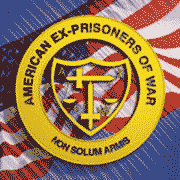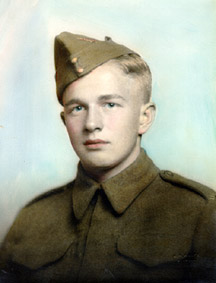
Established April 14, 1942
 |
American Ex-Prisoners of War
A not-for-profit, Congressionally-chartered veterans’ service organization advocating for former prisoners of war and their families.
Established April 14, 1942 |


|
||
| Last Name | First Name, Middle Init. | Nickname |
| Street Add. | City | State |
| Zip | Spouse | |
| Conflict | Branch of Service | Unit: |
| Theatre of Operation | Military Job | Where Captured |
| Date Captured | Time Interned | Camps |
| Date Liberated | Medals Received | Age at Capture |
| After the War ... | ||
I attended school in Detroit until the British Empire entered the war against the Axis powers. All my life I had imagined myself going off to war and coming home a war hero covered with medals. So when Canada joined Britain in the war, I decided that I would quit school and return to the country of my birth. I lied about my age and enlisted in the Kent Regiment, which was being activated as a Canadian Active Duty Force, in order to be able to join in the war against Germany and Italy.
I was a member of the Kent Regiment for about a year when my father wrote a letter to my Company Commander informing him of my age. They immediately discharged me because of underage. I returned to Detroit in February of 1941 and enlisted in the U.S. Army, February 21, 1941. 1 was asked where I wanted to go to serve my two years of Foreign Service. I had my choice out of several different parts of the world where the U.S.A., had Army bases, Schofield Barracks in Hawaii, Puerto Rico, Panama, and Manila in the Philippines. I chose Manila because it was a long way from home.
I left Detroit for Angel Island California, the same day that I enlisted. Our train left Union Station in Detroit for San Francisco at 4:00 P.M. on February 21, 1941. We waited a little over a month at Angel Island before we finally shipped out for the Philippine Islands on March 30. Seven days later we were docked in Honolulu. We were only there overnight; then we left on the final leg of our trip to the Philippines. We arrived in Manila April 22. Some of us were sent to Fort William McKinley, which is about sixteen kilometers from Manila for our basic training. During my basic training period I was rushed to the hospital for an emergency appendectomy.
When I recovered I was sent to Camp John Hay at Baguio for a recuperation furlough. I spent six weeks recuperating, and then I was returned to duty with "M" Company 31st Infantry stationed at Estado Mayor located on the Pasig River in Manila.
I was not back to duty long before I was sent back to the hospital with a very bad ear infection. This time when I returned to duty I was transferred from "M" Company to "D" Company, stationed at Cuartel De Espana inside the Walled City of Manila. When the Japanese bombed Pearl Harbor we were moved from our quarters to a park not far from the Manila Hotel. Each day we were deployed to a different large building where we set up our machine guns in a defensive position. When I was in the Canadian Army we had been taught never to fire our guns at targets you could not hit because all you would do is give your positions away.
We remained in the park until Christmas Eve, and then we were taken to the Port of Manila where we were ordered to load a ship with some large boxes and crates that were piled on the dock. We did not know where we were going, but we found out later that our destination was the island fortress of Corregidor in the mouth of Manila Bay. We remained on Corregidor until it was bombed for the first time on New Years Eve. After things settled down after that mammoth air raid we were moved to Bataan. We met the Japanese in combat several times but their equipment was far superior to ours, and the Japanese troops were trained much better than we were. So on April 9, 1942 the Bataan garrison was surrendered to the superior Japanese forces.
I was involved in the so-called Bataan Death March to Camp O'Donnell, but for some reason I got lucky and was moved from O'Donnell to Bilibid prison in Manila. The Death March was the most horrible experience most of us had ever seen. I did not believe in my wildest imagination that men could be as cruel as our captors turned out to be, but I will not go into that because it is now part of history.
I remained in Bilibid for about six months, and then I was moved to Cabanatuan Camp #1. This also was a very difficult experience, but I will not spend too much time on this period.
I remained in Cabanatuan until January 30, 1945 when the U.S. Army Rangers liberated the camp and released the remaining 511 prisoners left in the camp after the rest of the guys had been sent to Japan.
I have felt that ever since the Rangers released us from that camp that they were my heroes and probably will always be the greatest people I have ever had the privilege of meeting. If any members of the Ranger unit that released us from that camp reads this, THANK YOU ONCE AGAIN'. I feel that you guys saved my life. The 6th Army Rangers were my heroes of WWII.